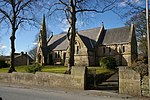Goldshaw Booth

Goldshaw Booth is a civil parish in the Pendle district of Lancashire, England. It has a population of 248, and contains the village of Newchurch in Pendle and the hamlets of Spen Brook (53.846°N 2.267°W / 53.846; -2.267 (Spen Brook)) and Sabden Fold (53.841°N 2.290°W / 53.841; -2.290 (Sabden Fold)). Pendle Hill lies to the north. The parish adjoins the Pendle parishes of Barley-with-Wheatley Booth, Roughlee Booth, Old Laund Booth and Higham-with-West Close Booth and the Ribble Valley parish of Sabden. It is part of the Forest of Bowland Area of Outstanding Natural Beauty (AONB).According to the United Kingdom Census 2011, the parish has a population of 248, a decrease from 265 in the 2001 census.Goldshaw Booth was once a township in the ancient parish of Whalley. This became a civil parish in 1866, forming part of the Burnley Rural District from 1894. The township extended to cover parts of the adjoining villages of Fence and Wheatley Lane, but this part transferred to Old Laund Booth in 1898. Parts of the parish also transferred to Sabden on its creation in 1904, and Newchurch in Pendle also used to straddle the boundary with Roughlee Booth but was brought entirely within the parish in 1935.Along with Higham-with-West Close Booth, Barley-with-Wheatley Booth and Roughlee Booth, the parish forms the Higham with Pendleside ward of Pendle Borough Council.
Excerpt from the Wikipedia article Goldshaw Booth (License: CC BY-SA 3.0, Authors, Images).Goldshaw Booth
Well Head Road, Borough of Pendle Goldshaw Booth
Geographical coordinates (GPS) Address Nearby Places Show on map
Geographical coordinates (GPS)
| Latitude | Longitude |
|---|---|
| N 53.85053 ° | E -2.27206 ° |
Address
Well Head Road
Well Head Road
BB12 9NB Borough of Pendle, Goldshaw Booth
England, United Kingdom
Open on Google Maps










